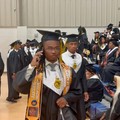I didn’t grow up coding robots or taking apart gaming consoles. My journey into tech started as a mom, a problem-solver by necessity, and someone who had to learn how to fix things fast when there was no one else around. One of the first times I realized just how much I loved tinkering was when I figured out how to bypass and reset an entire set of outdated insurance forms for work by writing a Python script—on my lunch break.
I worked in escrow and insurance tracking, and the process for notifying mortgage holders of expired policies was painfully manual. Agents would fax documents, forms would get lost, and everything relied on someone physically scanning pages into a clunky system that couldn’t handle bulk uploads. It frustrated me—not just because it was inefficient, but because it created real problems for real people. So I stayed late one night, watched about seven YouTube videos, and cobbled together a script that could auto-rename, sort, and flag missing fields in scanned documents. Then I shared it with a few coworkers, hoping it might save them time too.
The next morning, one of them told me she cried—not because of the script itself, but because she finally got to leave work on time. That moment lit something in me. I wasn’t just messing around with tech for fun anymore—I was building things that could actually improve people’s lives.
I didn’t stop there. I started using my new skills to make things more efficient in my everyday life, too. I taught myself how to automate repetitive household chores with Google Assistant routines. I helped my oldest son build a custom PC by researching every part and comparing prices to get the best performance for our budget. I created social media accounts for my clearance-deal brand and began experimenting with tools to automate post creation using AI and affiliate data.
What I love about technology is how limitless it feels—how even the smallest scripts or ideas can create ripple effects. Like Kyle Lam, I’m always experimenting, trying to figure out how to make something work better, even if no one’s done it that way before. I may not have a formal title as a developer (yet), but I’ve definitely delighted others with my hacker spirit. Whether it's improving my workflow, solving a problem for a coworker, or giving my kids something cool to be proud of, I tinker because I care. I build because I believe we can always make things better.
Now that I’m earning my bachelor’s degree in Computer Science, I finally feel like I’m giving that hacker spirit the structure and space it deserves. My ultimate goal is to create tools that help underrepresented families—single parents like me, folks in recovery, or small-town kids who think tech isn’t for them. Because if there’s one thing I’ve learned, it’s that sometimes the best builders are the ones who had to start with duct tape and Google.
“Done playing outside? Let me check you," my mother said, her nervous eyes scanning my bare legs. At age five, I didn’t understand Mom’s worries.
It wasn’t until I became a young adult that I processed my mother’s fears. My friend posted a story: “In Salto, a young girl dies of the Brazilian Spotted Fever (BSF) caused by a tick.” As I read, I was alarmed by my ignorance—I had seen many ticks, but now I understood my mom’s mandatory checks. Soon after, my school set up a meeting with the Biological Institute of Sao Paulo (BISP) to explain the science and dangers of ticks. “If you don’t get the treatment within seven days, the mortality rate of BSF can reach 80%! Ticks don’t have eyes or ears, but the three principal sensors they use to determine what they chase are temperature, breathing, and movement," the biologist explained.
My mind raced. Could we make a trap to attract ticks? How could we neutralize them? The idea seemed impossible. But I was curious. Within a day, I convinced my friends to help me create such a tool. Our professors contacted Shirley and Paulo, BISP’s biologists, who invited us to observe how they trap ticks with dry ice subliming into CO2 to mimic an animal’s breathing. We tucked our jeans inside our boots, sealed them with tape, and headed to Lake Park.
That whole afternoon, I felt excited. I had gone from playing on my farm, blind to a problem, to becoming aware and exploring potential solutions.
My first investigation focused on how to neutralize ticks. It couldn't be with pesticides or chemicals since they would harm plants and people. Then it hit me—I remembered running after mosquitoes on the farm with an electric fly swatter. Eureka! Let’s shock the ticks! I then started reverse-engineering an electric fly swatter to discuss if I could increase or decrease the output electricity to neutralize the ticks better.
After months of sketching, experimenting, and plenty of trial and error, I designed “Papa Tick,” a stationary solar-powered tick trap that combined dry ice with an electrified grid with different sizes to select unique life stages of ticks. Other professors in our high school were curious about our work, and they helped me and my friends with all sorts of tasks: 3D CAD, circuit design, writing documentation, and filling out a patent application. I was so grateful we had such fantastic support.
When I showed Papa Tick to my family, my mom was over the moon. Her pride shone brighter than I’d ever seen, but she also seemed worried – after all, I was working indirectly with ticks. She asked me if that was why I stayed more in school and worked more with random 3D-printed models scattered around my room. She told everyone in the family about my invention, and seeing her joy made all the tinkering feel even more worthwhile because it connected my passion for engineering and helping others.
The experience of creating Papa Tick was a transformative one that impacted my technical skills and overall perspective of innovating. Through the process, I learned how to work effectively as part of a team, communicate with experts in a specific field, and apply my coding, tinkering, and design knowledge to solve real-world problems.
I am eager to see what new challenges await that I can jump on to and grasp with childlike optimism, enthusiasm, and wonder. I’m never entirely done playing outside.
I love building/creating, especially when it's to solve a problem. It's part of the reason I have a special interest in engineering, and I hope to be able to do some level of engineering along with research through my physics degree. When thinking about all the things I've built, one, in particular, reminds me of what was written here about Kyle Lam and the "hacker" spirit he carried.
My dad is extremely into barbequing. He will spend an entire day cooking dinner if he has time, making sure the smoker has the right type of chips, the marinating or dry rub is just right, and most importantly: that the temperature stays perfect. He has a thermometer that senses the temperature of the meat and the inside of the smoker and controls a fan to moderate it based on that. He wanted to be able to watch it all day though, and it's quite heavy and an odd shape. Plus the counter near the grill is always covered in food and other stuff he wouldn't want to get on it.
He came to me asking how he could keep the thermometer in an easy-to-see, but safe place, and I set to work. The first thing I did was take a contour gauge out to the countertop; it wasn't just a squared-off edge, so I had to carefully trace its shape onto a piece of paper. I scanned that shape onto my computer and through CAD (3d design) software, I recreated the outline of the counter. I also took measurements of the thermometer and modeled a holder that could sit on the counter. Due to the weight of the thermometer being farther back, it wouldn't slide off. Careful to select a filament that wouldn't get damaged by rainwater (I knew my dad would forget to put it away), I 3d printed my holder.
It took a few tries, the first ones didn't slide onto the counter as easily as I would have hoped, and one even snapped in half in trying to force it on. Eventually, I printed one that easily slid on, and gave it to my dad. He loves it and has one more tool in his BBQing toolbox (yes, that's a thing he has...).
I know this isn't that big of a creation or even something that many people could use, but I think it embodies that hacker spirit. It was a fun thing to make to a very unique problem and getting to give my dad something that makes it slightly easier to enjoy his hobby made me happy. I also think it shows how many of life's smaller problems can be solved by technology. Of course, we should focus on the bigger issues that worry humanity, but we shouldn't forget that this technology (like 3d printing) can also be used for everyday nuisances to make our lives just a little bit easier.





















